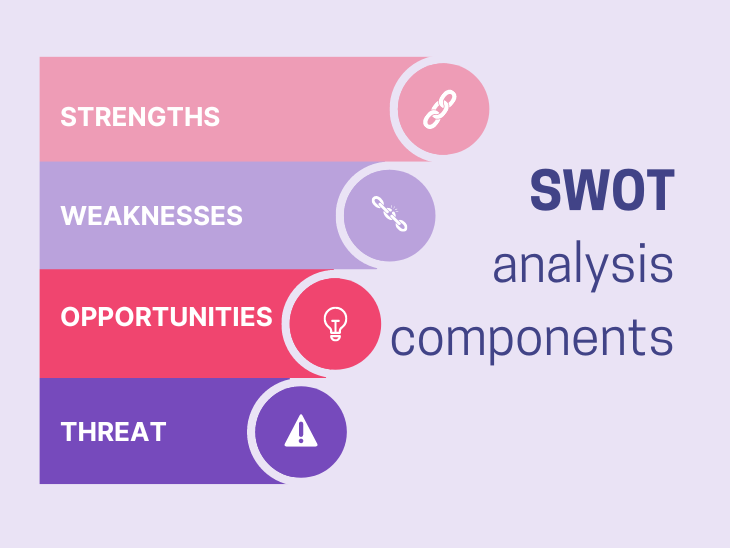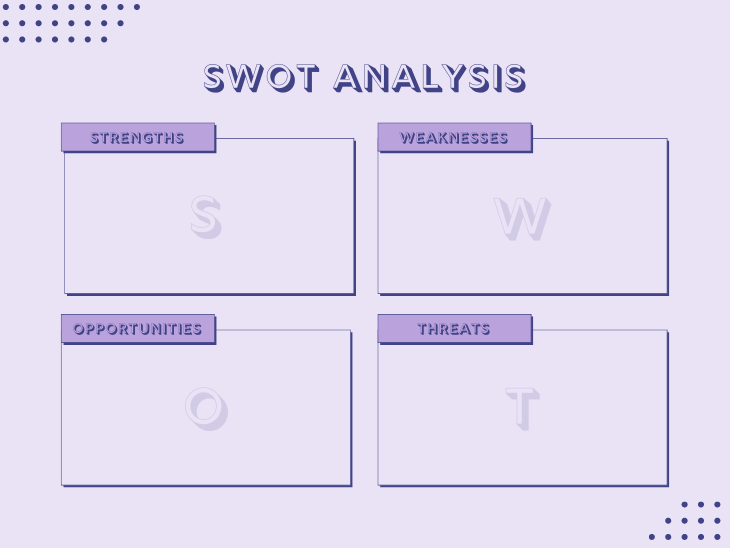One thing every organization has in common is a desire to expand their business, the success of which depends on proper research and evaluation.

A SWOT analysis is an excellent tool to help you determine where you stand in the market, identify growth opportunities, and assess how to overcome potential roadblocks along the way.
A SWOT analysis is a method for evaluating four key components of your company:

The main objective of a SWOT analysis is to raise awareness of the variables that influence business decisions and strategies. In other words, you are examining the internal and external factors that affect your firm.
Internal factors are in your control, whereas external factors usually are not. In either instance, these variables will identify the best course of action to take.
SWOT analysis is frequently employed by businesses, by nonprofit organizations, and, to a lesser extent, by individuals for self-evaluation.
A SWOT analysis is used for projects, goods, and activities. For instance, CIOs can use SWOT to assist in the production of a template for strategic business planning or in a competitive study.
You might consider using a SWOT analysis before deciding to take any kind of firm action in evaluating new projects, revising internal policies, looking at possibilities to pivot, or changing a plan in the middle of its implementation.
Sometimes it makes sense to do a general SWOT analysis to assess your company’s present environment and make any necessary operational improvements.
The research can highlight the key areas in which your company is operating at its best as well as where processes require improvement.
Businesses and individuals commonly use a SWOT analysis to:
Avoid thinking casually about your company’s operations in the hopes that they will all work together harmoniously. Taking the time to create a comprehensive SWOT analysis can help you gain a complete view of your company. From there, you can figure out how to strengthen or get rid of your company’s deficiencies while maximizing its strengths.
A SWOT analysis should undoubtedly involve the firm owner, but it is usually beneficial to incorporate other team members as well. Ask a range of team members for their opinions, then discuss any contributions in an open forum. You will be able to assess your company effectively from all angles thanks to the team’s comprehensive knowledge.
The SWOT analysis is also applicable at the project level. In that case, team members and project managers who are in charge of making decisions and developing strategies frequently employ a SWOT analysis.
One of the biggest advantages of a SWOT analysis is its simplicity. All you truly need is a mechanism to record ideas and the courage to examine your company head-on.
When conducting a SWOT analysis, you examine:
A SWOT analysis begins with a 2×2 grid, as pictured below:

When you start your analysis, write down ideas in the appropriate quadrant as you brainstorm. If you are conducting this in-person, you can simply use a white board with sticky notes. You might consider using software, such as Miro or Figma if you are conducting it remotely.
Your strengths can be things that your team or business does well. Keep in mind that strengths are internal, so you must look within to find them. Strengths are something you have control over and can build off of.
Below some examples of brainstorming questions you might ask at this stage:
Below are some examples of strengths that you might identify during a SWOT analysis:
Weaknesses are the areas in which your team or business needs to improve.
Similar to strengths, this section demands introspection. It includes internal issues that you find. You can often change and gain more control over your weaknesses.
Below some examples of brainstorming questions you might ask at this stage:
Below are some examples of weaknesses that you might identify during a SWOT analysis:
Opportunities are the methods and tools you can use right away as a business.
Opportunities are not within your control because they are not a part of your company, but rather in the market. You can only move in the direction of the opportunities if you know where they are.
Below some examples of brainstorming questions you might ask at this stage:
Below are some examples of opportunities that you might identify during a SWOT analysis:
Threats are potential issues or challenges you could face as a business.
Again, threats are external factors, so they are things that happen outside of your business. They aren’t controllable, but you can actively plan for them.
Below some examples of brainstorming questions you might ask at this stage:
Below are some examples of threats that you might identify during a SWOT analysis:
The next step is to reorganize the insights to find potential strategic options to pursue, make decisions, and incorporate them into your strategic plan.
Answer the following questions using the components from the SWOT framework:
By providing answers to these questions, you reveal potential strategic choices. You can then analyze and assess the best course of action.
Making decisions is the essence of strategy, and this study is designed to assist you in reducing your options for further consideration. You should create and monitor an action plan to make sure the following steps are done in a way that does not lose momentum. Update your strategic plan, establish long-term and short-term objectives, and create an action plan to involve the entire team.
The SWOT analysis template allows you to succinctly describe and collect all the relevant information required to conduct a SWOT analysis. Each section of the graph highlights a component of the SWOT analysis.
The upper half of the graph emphasizes internal factors, whereas the lower half denotes external factors. The left and right side of the graph specifies positive and negative factors, respectively.
To use this SWOT analysis template, follow this link and select File > Make a copy from the main menu bar:

Businesses that are successful have an internal and external focus. They reflect on themselves while simultaneously observing their surroundings.
Before you can make any strategic decisions, you must first analyze your current situation. A SWOT analysis offers a direct route to this kind of in-depth comprehension.
The SWOT technique helps you determine how to proceed after you’ve evaluated your situation, and offers insights on effective tactics for achieving your goals.
Featured image source: IconScout

LogRocket identifies friction points in the user experience so you can make informed decisions about product and design changes that must happen to hit your goals.
With LogRocket, you can understand the scope of the issues affecting your product and prioritize the changes that need to be made. LogRocket simplifies workflows by allowing Engineering, Product, UX, and Design teams to work from the same data as you, eliminating any confusion about what needs to be done.
Get your teams on the same page — try LogRocket today.

Most teams fail at autonomy. Learn how clear rules help product teams move faster without micromanagement.

A practical framework for PMs to use AI in ideation without sacrificing judgment, strategy, or decision quality.

A practical five minute revenue estimation method to help product managers compare ideas, drop low impact features, and prioritize smarter.

A practical guide for PMs who want to stop being bottlenecks, delegate smarter, and lead teams effectively with a clear ownership framework.